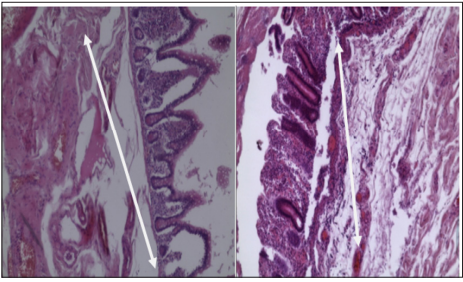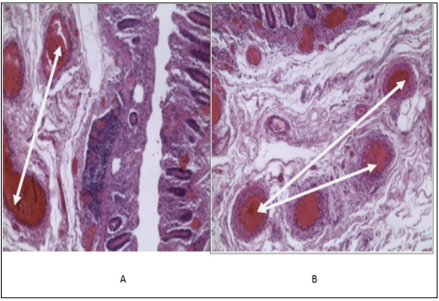Impact Factor : 0.548
- NLM ID: 101723284
- OCoLC: 999826537
- LCCN: 2017202541
Zhumanazarov NA*1, Kamyspayev MU2 and Temirbekov AN3
Received: October 31, 2018; Published: November 06, 2018
*Corresponding author: Zhumanazarov NA, Pathology Department, Medical School, Kazakhstan
DOI: 10.26717/BJSTR.2018.10.002010
To this article it is investigated changes of walls of a small intestine concerning intestinal impassability. In it many various and difficult pathological mechanisms sharp impassability of intestines because of various etiology, estimating depth and reversibility of damage and the microcirculation changes in an intestines wall are revealed.
Keywords: Small Intestine; Mechanisms; Damages; Microcirculation
The Sharp Intestinal Impassability (SII) for many years remains to one of the most actual, complex and stubborn problems of urgent abdominal surgery [1,2]. Still remain almost not studied the changes happening in a small intestine after restoration of a bloodgroove when the gut admits viable and plunges into an abdominal cavity. At the same time, according to a number of authors, the small intestine is highly sensitive body concerning ischemia [3,4]. In recent years it isn’t achieved considerable success in the field of diagnostics and treatment of the sharp intestinal impassability (SII) which is the reason of 1,2-14,2% of all emergency surgical interventions. Patients with impassability of intestines make up to 3,5% of total number of patients in surgical hospitals. In structure of the emergency surgical diseases the share of sharp intestinal impassability reaches 9,4% [3,5,6]. In absolute numbers there is steady growth of number of patients to OKN, especially adhesive as in connection with development of anesthetic equipment it began to be carried out more difficult, and, therefore, more traumatic abdominal operations [7-9]. Lethal outcomes at sharp intestinal impassability make 10,7-64,7% [9-11].Moreover, growth of a lethality at this pathology is observed and makes 43,7-64,7% [10,12]. Data on objectification of structural violations which arise in a wall of a small intestine at sharp intestinal impassability and their corrections at the person are small, as has defined need of performance of this work. The purpose of the study- was to study the state structures of the tissues of the wall of the small intestine in acute strangulation obstruction in humans.
Material was taken during surgery for resection of the small intestine over the period 2011-2015. According to nosological units: for acute intestinal obstruction by strangulation type -5 cases (strangulated femoral hernia in 3 cases, inguinal hernia - 2), about the thrombosis of the branches of the upper mesenteric arteries and veins 5 case. In 3 cases, resection was performed about adhesive intestinal obstruction. As a control used the fragments of the small intestine, which were taken at autopsy 5 dead through 3-9h after death from diseases not related to pathology of the gastrointestinal tract. Pathologically changed organs were fixed in 10% buffer neutral formalin was paraffin. After posting in paraffin, histological sections with a thickness of 5-6 microns were made by microtome “Leica” and were stained with hematoxylin-eosin according to the morphological division of the study. Histochemical study of the activity of succinate dehydrogenase and acid phosphatase was carried out according Burstone [4].
Postmortem Examination Revealed the Following: Small bowel after resection for acute strangulated obstruction was increased in diameter, inflated, c serous membrane is dim, almostblack, discharge loop spasmodic. In all cases clinically were expressed, peritoneal phenomena that have characterized the presence of acute generalized peritonitis of varying severity. In lesions the loop of intestine on the basis of massive hemorrhagic infarction was observed necrosis of the bowel wall. Even with minor disease duration (6-9h) by staining with hematoxylin and eosin in the intestinal wall were observed edema, lymphedema, hemorrhagic infarction of tissues with diffuzomation of purulent inflammation of the mucosa and pockets of bacteria build-up. In the dilated vessels of the submucosa of the, stasis of blood, and small hemorrhages. In the immediate area of necrotic areas (5-10cm), causing loops of the small intestine blood vessels are filled with blood. In the mucosa there are significant changes [13-15].
The epithelium of the intestinal villi is separated from the condensed stroma of the villi throughout the edematous fluid. The boundaries between the columnar absorptive the enterocytes are practically the same, their nuclei are frequently displaced in apical direction. The tops of many of the villi “naked”, their epithelium slues, which corresponds to the III-severity of morphological damage of epithelial lining of the villi of the small intestine in C Chiu et al. [11]. In sections taken at the border of small bowel resection within life-able fabrics (50cm), there is swelling of all layers of the bowel wall. Microgametocyte in a state of stasis, a ubiquitous phenomenon leuko-diapedeses. Loose connective tissue stroma of the intestinal villi sealed, infiltrated polymorphocellular elements. The lint everywhere phenomena subepithelial edema. Columnar epithelial cells are swollen, their height is reduced, the cytoplasm is cloudy, the kernel is shifted in the apical direction. The number of goblet cells increases. The functional properties of the enterocytes are violated. Dramatically decreasing the activity of succinate dehydrogenase, which is localised control in the form of dark blue granules in the apical and basal pole of enterocytes. At a distance of 50cm from the ligature marks, the number of granules, which indicate the activity of the enzyme, a minor, is determined only by pale fine-grained texture. Localization and intensity of staining of enterocytes in the determination of acid phosphatase changed with increasing amount of deposited reaction product, in comparison with the control.
In the study of the bowel wall, which was subjected to resection regarding thrombosis of the branches of the superior mesenteric artery and vein, we identified severe ischemic and inflammatory changes resulting in its loop at a distance of 50cm from the border of necrosis. At a distance of 10-20cm from the necrotic changed area of an intestine there is swelling of all membranes of the body wall. In the mucous membrane, it manifests itself by a significant extension of subepithelial space. The intestinal villi are of unequal length, the exposed tops and in some of them the enterocytes listening from the top to the base of the villi. The enterocytes swollen, their cytoplasm is cloudy, the nuclei of different sizes are deployed in the direction of the apical pole is detected karyopyknosis separate cores. The border of the enterocytes did not distinguish. The degree of mucosal damage mainly III, sometimes IV sites are characterized by a degree of damage where there is disintegration of the lamina propria of the mucous membrane with hemorrhages and ulceration. Crypts and focal cropped destroyed. In the stroma of the villi polymorphocellular infiltration (Figures 1a & 1b).
Figure 1: Injuries of a mucous membrane of III degree. Coloring by hematoxylin and eosin. The increase approx. 10. about 40.

At a distance of 50cm leading loop in the crypts cells stored, and you can hope for the regeneration of the epithelial layer of the intestine. The activity of succinate dehydrogenase in enterocytes dramatically reduced. When setting the reaction to acid phosphatase, the enterocytes are painted unevenly. Only at a distance of 50-55cm above the zone of necrosis histological structure of intestine stabilize while maintaining a slight swelling and inflammatory lymphocytic infiltration (I-II degree of damage). In adhesive intestinal obstruction a resection volume were different - from 20cm to the entire ileum. The section of intestine that were subjected to resection, as a rule, were deformed, narrowed in diameter, with a thickened wall. Adhesions consisted of dense connective tissue, adherent to the serous membrane of bowel wall. The muscular coat moderately hypertrophied. In the mucosa revealed significant changes – swelling of the stroma of the villi, swelling of enterocytes, a decrease in the activity of succinate dehydrogenase, which is evidence of II-III degree of damage (Figures 2 & 3).
Figure 2: Micro circulator changes with formation of a thromboembolic in an intestinal wall. Coloring by hematoxylin and eosin. The increase approx. 10. about 40.

Figure 3: Dystrophic and necrobiotic changes of the villi of the mucous membrane. Coloring by hematoxylin and eosin. The increase approx. 10. about 40.

Thus, despite the complexity and diversity of the pathological mechanisms of acute intestinal obstruction of different etiology share key link in determining the depth and reversibility of the lesion, are microvascular changes in the intestinal wall. They wear the same type of character, depend on the type of intestinal obstruction and duration of the postoperative period after resection of the necrotic modified loop of the small intestine.
a) Histopathological changes and resulting discharge loop of the intestine of a person at different distances from necrotic areas have obvious features. Within the conventional resection of 50 cm lead and 20 cm outlet loop - they differ depending on the type of obstruction.
b) A comprehensive study of the wall of the remote portion of the small intestine histological, histochemical methods with obstruction showed the difficulty of resection in the conventional boundaries because of its lack of viability.
c) Changes in the enterocytes may serve as an indicator of damage of the intestinal mucosa in combination with damage to its nervous structures.


